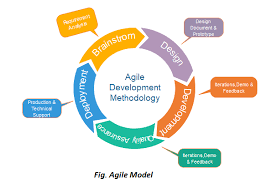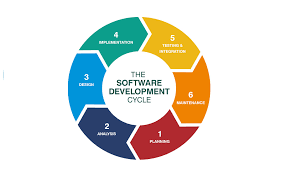Software Engineering: Agile Development
Agile development is a software engineering approach that emphasizes flexibility, collaboration, and iterative development. It focuses on delivering high-quality software in a more efficient and adaptive manner compared to traditional waterfall methodologies.
In agile development, projects are divided into small increments called sprints. Each sprint typically lasts for a few weeks and involves planning, designing, coding, testing, and reviewing the software. This iterative process allows for regular feedback from stakeholders and enables teams to respond quickly to changing requirements.
One of the key principles of agile development is the prioritization of customer satisfaction through early and continuous delivery of valuable software. This approach helps ensure that the final product meets the needs of the end-users and can be adapted based on their feedback throughout the development process.
Another important aspect of agile development is the emphasis on collaboration and communication within cross-functional teams. By promoting open dialogue and shared responsibility, agile methodologies help foster a culture of teamwork and innovation that leads to better outcomes for software projects.
Overall, agile development has become increasingly popular in the software engineering industry due to its ability to deliver high-quality software more efficiently, adapt to changing requirements, and promote collaboration among team members. By embracing agile principles and practices, software engineers can build better products that meet the needs of their users while staying responsive to evolving market demands.
9 Essential Tips for Mastering Agile Development in Software Engineering
- Embrace change and be flexible with requirements.
- Communicate regularly with your team and stakeholders.
- Deliver small, incremental updates frequently.
- Prioritize tasks based on customer value.
- Conduct regular retrospectives to improve processes.
- Encourage collaboration between cross-functional teams.
- Automate testing to ensure code quality and reduce manual effort.
- Keep documentation up-to-date but lightweight.
- Focus on delivering working software over comprehensive documentation.
Embrace change and be flexible with requirements.
Embracing change and maintaining flexibility with requirements is a fundamental tip in software engineering agile development. By acknowledging that requirements are likely to evolve throughout the development process, teams can adapt quickly to new information and feedback from stakeholders. Being open to change allows for a more responsive and iterative approach to software development, ultimately leading to better outcomes and increased customer satisfaction. Prioritizing flexibility in requirements ensures that the final product aligns closely with the needs of users and can easily accommodate shifting priorities in a dynamic business environment.
Communicate regularly with your team and stakeholders.
Regular communication with your team and stakeholders is crucial in software engineering agile development. By maintaining open and transparent dialogue, you can ensure that everyone is on the same page regarding project goals, progress, and any potential challenges. This ongoing communication helps to foster collaboration, identify issues early on, and make informed decisions that align with the project’s objectives. Ultimately, keeping all stakeholders informed and engaged throughout the development process leads to better outcomes and a more successful software project.
Deliver small, incremental updates frequently.
In software engineering agile development, a key tip is to deliver small, incremental updates frequently. By breaking down the project into manageable chunks and releasing updates regularly, teams can gather feedback early and often, allowing for quick adjustments and improvements. This iterative approach not only ensures that the software remains aligned with user needs but also promotes a more efficient development process that adapts to changing requirements in a timely manner.
Prioritize tasks based on customer value.
In software engineering agile development, it is crucial to prioritize tasks based on customer value. By focusing on delivering features and functionalities that provide the most value to the end-users, teams can ensure that the final product meets their needs and expectations. This approach not only helps in maximizing customer satisfaction but also enables teams to make informed decisions about where to allocate resources and effort during the development process. Prioritizing tasks based on customer value ensures that the software being developed is aligned with the users’ requirements and preferences, ultimately leading to a more successful and impactful product.
Conduct regular retrospectives to improve processes.
Conducting regular retrospectives is a valuable tip in software engineering agile development. By taking the time to reflect on past sprints and projects, teams can identify areas for improvement in their processes and workflows. Retrospectives provide an opportunity to celebrate successes, address challenges, and implement changes that can lead to more efficient and effective development practices. Through open communication and a commitment to continuous improvement, teams can use retrospectives to foster a culture of learning and innovation that ultimately enhances the quality of their software products.
Encourage collaboration between cross-functional teams.
Encouraging collaboration between cross-functional teams is a crucial tip in software engineering agile development. By fostering open communication and shared responsibility among team members with diverse skill sets, projects can benefit from a wealth of perspectives and expertise. This collaborative approach helps break down silos, promotes innovation, and ultimately leads to more successful outcomes by leveraging the strengths of each team member towards a common goal.
Automate testing to ensure code quality and reduce manual effort.
Automating testing in software engineering agile development is a crucial tip to ensure code quality and streamline the development process. By automating testing procedures, developers can quickly identify and address bugs, errors, and inconsistencies in the codebase, leading to higher-quality software products. This approach not only improves the overall reliability of the software but also reduces the manual effort required for testing, allowing teams to focus more on innovation and delivering value to end-users.
Keep documentation up-to-date but lightweight.
In software engineering agile development, it is essential to keep documentation up-to-date but lightweight. This means ensuring that all relevant information about the project is documented in a timely manner, while also avoiding excessive and unnecessary details that can slow down the development process. By maintaining concise and accurate documentation, team members can stay informed about project requirements, progress, and decisions without being overwhelmed by unnecessary information. This approach helps promote transparency, collaboration, and efficiency within the team, ultimately leading to more streamlined and successful software development projects.
Focus on delivering working software over comprehensive documentation.
In software engineering agile development, it is crucial to prioritize delivering working software over comprehensive documentation. By focusing on tangible results and functional software, teams can ensure that they are meeting the needs of their users and stakeholders in a timely manner. While documentation is important for providing context and guidance, the primary goal should always be to produce software that adds value and can be tested and validated by end-users. This approach not only accelerates the development process but also allows for more effective collaboration and feedback loops within the team, ultimately leading to higher-quality outcomes.




